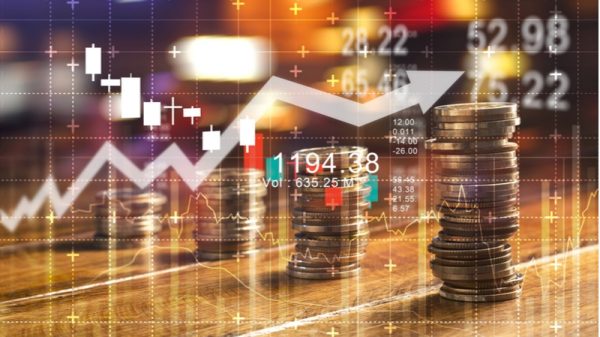The pharmaceutical industry is a major player in the overall life science sector, responsible for developing and manufacturing the majority of prescription drugs.
Companies in this space are constantly researching and creating innovative treatments for various medical conditions. In recent years, there has been a particular focus on developing new treatments for diabetes, weight loss and cancer.
With the pharmaceutical sector projected to reach a staggering US$1.6 trillion in total revenue by 2028, there is an opportunity for investors to gain exposure to the growth potential of this industry while also benefiting from the diversification and stability provided by established companies.
1. Eli Lilly and Company (NYSE:LLY)
Market cap: US$772.11 billion
Founded in 1876, Eli Lilly and Company employs approximately 10,000 individuals for research and development in seven countries and has products marketed in 110 countries, including therapies for diabetes, cancer, immune system diseases and a wide range of mental health conditions. The company also has drugs in development for various medical conditions, such as skin ailments, cancers, Crohn’s disease, diabetes, obesity and Alzheimer’s disease.
Eli Lilly’s Alzheimer’s disease drug donanemab completed its Phase 3 trial in May 2023, with test results showing a ‘significant’ slowing of cognitive and functional decline for people with early symptoms of the disease. The drug, sold under the name Kisunla, was approved by the US Food and Drug Administration on July 2, 2024.
2. Novo Nordisk (NYSE:NVO)
Market cap: US$484.11 billion
Danish company Novo Nordisk has demonstrated a commitment to addressing various health conditions, such as type I and II diabetes, obesity, hemophilia and growth disorders, and markets its therapies in 170 countries. The company’s main product is the diabetes drug Ozempic, which is also marketed for obesity under the name Wegovy
It has been conducting research into a new obesity treatment called amycretin, which targets both GLP-1 and amylin receptors. Phase 2 trials are ongoing, but early-stage results show that volunteers taking amycretin have lost up to 13.1 percent of their body weight after 12 weeks, compared to 6 percent seen in patients taking Wegovy, which only targets GLP-1, according to the company.
Novo Nordisk has a working partnership with Microsoft (NYSE:MSFT) through which it uses the tech giant’s artificial intelligence (AI), cloud and computational services to facilitate the discovery of new drugs and treatments. The firm announced in March it will work with AI heavyweight NVIDIA (NASDAQ:NVDA) to build the Danish Center for AI Innovation, which will host an NVIDIA supercomputer and will run on 100 percent renewable energy.
3. Johnson & Johnson (NYSE:JNJ)
Market cap: US$366.83 billion
Johnson & Johnson operates on a massive scale and encompasses various segments through its subsidiaries. Its primary pharmaceutical subsidiary is Janssen Pharmaceuticals, which focuses on cardiovascular disease and metabolism, infectious diseases and vaccines, neuroscience, oncology, immunology and pulmonary hypertension.
Johnson & Johnson acquired a clinical-stage biopharmaceutical company called Ambrx Biopharma on July 3, which will allow the company to further develop antibody-drug conjugates, expanding its offering of targeted oncology therapies.
Following positive data from a Phase III study, on January 30 the company submitted its drug Darzalex Faspro to the FDA for the treatment of newly diagnosed multiple myeloma in patients who are eligible to receive a transplant. The agency approved the treatment on July 30. Johnson & Johnson submitted the same request to the European Medicines Agency on March 4, but it has not received approval there at the time of this writing.
On November 8 the company submitted the drug to both agencies for approval as a treatment for a new indication, high-risk smoldering multiple myeloma, which is an asymptomatic condition that is a precursor to multiple myeloma.
4. AbbVie (NYSE:ABBV)
Market cap: US$320.74 billion
AbbVie is a global biopharmaceutical company that discovers and delivers innovative medicines and solutions to address complex health issues. The company has identified five areas of focus where it believes it can make a significant impact in improving treatments for patients: immunology, oncology, neuroscience, eye care and aesthetics.
Its biggest performer was Humira, a therapy for autoimmune conditions such as rheumatoid arthritis and Crohn’s disease, but its exclusivity ended in 2023 and biosimilars have now entered the market.
On February 28, AbbVie announced a strategic partnership with OSE Immunotherapeutics (LSE:0RAD,EPA:OSE), a clinical-stage immunotherapy company, to develop a monoclonal antibody to treat chronic and severe inflammation.
‘This collaboration underscores our commitment to expanding our immunology portfolio with the ultimate goal of improving the standard of care for patients living with inflammatory diseases globally,’ said Jonathon Sedgwick, PhD, senior vice president and global head of discovery research at AbbVie.
The firm cemented that point with the March 25 news that it has entered a definitive agreement to acquire Landos Biopharma (NASDAQ:LABP), a clinical-stage biopharma company that develops oral therapeutics for autoimmune diseases.
On October 31, the company entered into a collaboration agreement with biotech company EvolveImmune Therapeutics to develop biological cancer therapies using EvolveImmune’s proprietary EVOLVE T-cell engager platform.
5. Merck & Company (NYSE:MRK)
Market cap: US$257.64 billion
Merck & Company has an extensive portfolio of products, including treatments for conditions such as diabetes and cancer, as well as vaccines for a variety of diseases.
Merck has a robust research and development pipeline, with over 80 programs currently in Phase II trials, over 30 in Phase III trials and more than 10 under review. The company is actively pursuing treatments for a range of conditions, including HIV, Ebola, hepatitis C, cardio-metabolic disease and antibiotic-resistant infections.
On March 13, Merck revealed plans to develop a new version of its human papillomavirus (HPV) vaccine Gardasil; it will be a multi-valent vaccine that will protect against more strains of HPV. The company also plans to run a separate trial to evaluate the results of a single dose of Gardasil 9, its current vaccine, compared to the previous three-dose regimen. Merck intends to begin the two trials in the fourth quarter of 2024.
On September 18, the FDA approved Merck’s cancer drug Keytruda for the treatment of unresectable advanced or metastatic malignant pleural mesothelioma (MPM) in adult patients, in combination with pemetrexed and platinum chemotherapy.
The company received a second nod of approval from the FDA on December 3 when the agency granted breakthrough therapy status to Merck’s investigational drug sacituzumab tirumotecan for the treatment of patients with treatment-resistant advanced or metastatic nonsquamous non-small cell lung cancer, as well as epidermal growth factor receptor mutations.
FAQs for pharmaceutical stocks
What does the pharmaceutical industry do?
The pharmaceutical industry encompasses a variety of companies that have different — although sometimes overlapping — roles to play. The most famous players are the ‘Big Pharma’ companies. These giants often have a variety of subsidiaries, large pipelines and many products in their portfolios.
There are also smaller pharma R&D companies, which sometimes get acquired by larger firms if their work seems promising. Companies in these categories research, develop and bring to market drugs aimed at filling unmet needs, or helping people who are resistant to pre-existing treatments.
Once patents run out on prescription drugs, generic drug manufacturers create much cheaper generic versions. Wholesale companies also play a large role in the pharma sector. According to Common Wealth Fund, wholesalers have four areas through which they affect drug buying and distribution: ‘setting generic drug prices, leveraging list price increases, competing in specialty drug distribution, and mitigating or exacerbating drug shortages.’
What is the big pharma business model?
Big Pharma companies have a fairly consistent business model. Often, the company’s R&D team will slowly develop a new drug through many stages of testing to prove the drug’s efficacy, safety and necessity.
If all trials are completed successfully, the company will apply to government organizations such as the FDA, which must approve the drug before it can be mass produced, marketed and sold. Companies can skip a number of these steps by acquiring smaller companies, or through in-licensing, which results in two companies sharing the burden of a drug’s development through to commercialization. However, it’s worth noting that large pharma companies have many drugs in their pipelines at any given time, and many don’t make it to approval.
Once a drug is approved by the relevant health organization, it can be marketed and prescribed. Because patents expire after 20 years, companies lobby and advertise to try to get as many sales as possible during that window.
Who are the ‘Big 3’ in pharma?
The ‘Big 3’ in pharma refers to the three largest wholesalers: AmerisourceBergen (NYSE:ABC), Cardinal Health (NYSE:CAH) and McKesson (NYSE:MCK). Collectively, those three companies account for over 92 percent of wholesale prescription drug distribution in the US.
Which country is number one in the pharma industry?
The US is the top pharmaceutical country, with five of the top 10 pharma companies by revenue headquartered in the nation. The country is also in the lead when it comes to consumer spending on pharmaceuticals — this is due to the high cost of brand-name drugs. Aside from that, the US is the top country globally for R&D spending — companies that are part of PhRMA, a trade group that represents US biopharmaceutical companies, spent US$96 billion on R&D in 2023 out of a total of over US$300 billion spent by pharmaceutical companies globally that year.
What is the future of pharmaceuticals?
Pharmaceutical companies will have to adapt to changing times. The world is shifting, with economic woes, geopolitical disruptions and supply chain concerns affecting nearly every sector. Innovation continues to accelerate as well, and the medical landscape has changed in the wake of COVID-19. Additionally, the US government is making moves to address the astronomical prices of prescription medicine as the industry comes under more scrutiny.
For a look at what is else is effecting the market, read our 2024 Pharma Market Forecast.
Are pharmaceutical stocks risky?
While established players like the Big Pharma and wholesale companies discussed above should be relatively consistent, small companies are make-or-break depending on whether their drugs are successful. This means that investors could see much higher returns compared to large companies, but run the risk of taking massive losses in the case of failure.
Securities Disclosure: I, Meagen Seatter, hold no direct investment interest in any company mentioned in this article.
























